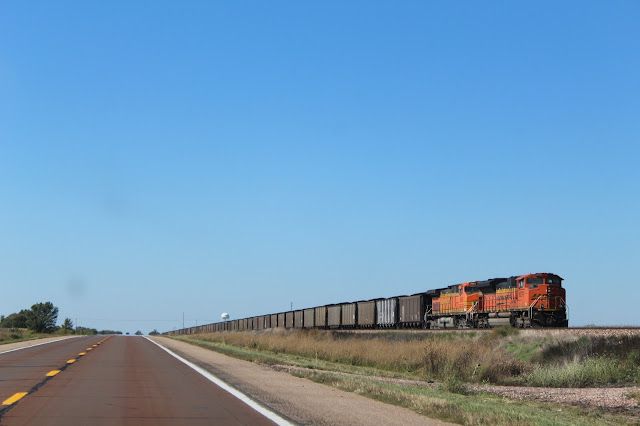“Now, where was I??”
Hello, All. Seems my cold got the better of me yesterday, but
hey, we’re back. And I wake up to thunderstorms this morning in Pierre, the
capitol of South Dakota. I can safely say that very rarely do I get a rain-out
day. More about my reason for being in Pierre in a bit.
I did mention earlier that I was going to continue with
something from Wednesday. That was a visit to the Golden Spike Tower, an
8-story observatory in North Platte where you can view Bailey Yard, the largest railroad
classification yard in the world. At 2 miles high and 8 miles long, this yard
assembles, disassembles and inspects upward of 120 freight trains per day. As seen from the tower:
The fueling and sand stands.
The main office building.
And a panoramic view of the yard.
Find out more on the Union Pacific at http://www.up.com/
Find out more on the tower at http://goldenspiketower.com/
Find out more on the tower at http://goldenspiketower.com/
As I said on Thursday, I was driving thru what is a new part
of Nebraska for me. And the one thing I see was these rolling hills. Now I have driven thru the rolling hills before when taking US 83 from North Platte to
Pierre, but on this trip there were some signs that I noticed along US 83. And while I was watching the
Burlington Northern Santa Fe move its coal trains, the ubiquitous light bulb
went off in my head. Pentrex, which is a producer of railroad DVDs, did a video
on the then Burlington Northern running thru the Sandhills of Nebraska. And on Friday, I looked at the short grasses
and short shrubs of the hills and you see the sand. Just like sand at the beach.
To explain more on this, a word from our friends at
Wikipedia.Org:
"The Sandhills, often written Sand Hills, is a region of
mixed-grass prairie on grass-stabilized sand dunes in north-central Nebraska,
covering just over one quarter of the state. The dunes were designated a National
Natural Landmark in 1984.
"The boundaries of the Sandhills are variously defined by
different organizations. Depending on the definition, the region's area can be
as small as 19,600 square miles or as large as 23,600 square miles.
Dunes in the Sandhills may exceed 330 feet in height. The
average elevation of the region gradually increases from about 1,800 feet in
the east to about 3,600 feet in the west.
"The Sandhills sit atop the massive Ogallala Aquifer; thus
both temporary and permanent shallow lakes are common in low-lying valleys
between the grass-stabilized dunes prevalent in the Sandhills. The eastern and
central sections of the region are drained by tributaries of the Loup River and
the Niobrara River, while the western section is largely composed of small
interior drainage basins.
"The World Wide Fund for Nature (WWF) designated the
Sandhills as an ecoregion, distinct from other grasslands of the Great Plains.
According to their assessment, as much as 85% of the ecoregion is intact
natural habitat, the highest level in the Great Plains. This is chiefly due to
the lack of crop production: most of the Sandhills land has never been plowed."
More information can be found at https://en.wikipedia.org/wiki/Sandhills_(Nebraska)
But now, as least in Nebraska, there were a number of signs
along US 83 saying, “Save the Sandhills”. The main reason for this is from the
website www.SaveTheSandhills.Com
which says:
"The R-Project [of the Nebraska Public Power District] is
a 220 mile long 345kV transmission line that is proposed to dissect the
Sandhills at its heart. The unsightly towers will create havoc on the Sandhills
by requiring large equipment to drive across the virgin grassland dunes,
tearing up the sensitive soil and scarring the land for generations to come.”
In the years that I traveled thru the Sandhills, its beauty
is as amazing as the Grasslands and the Badlands of South Dakota, the prairies
of Nebraska and even the National Seashore near me in Cape Cod, Massachusetts.
And there is a quote from the Sandhills website from former president
Lyndon B. Johnson:
“If future generations are to remember us with gratitude
rather than contempt, we must leave them more than the miracles of technology. We
must leave them a glimpse of the world as it as in the beginning, not just after
we got through with it”.
Now mind you, the railroads and highways were built thru the
Sandhills and the Prairies long before we came along. These paths brought the settlers
who developed the lands for farming and which brought commerce to all parts of
our great country. But I have to agree with Mr. Johnson: we must leave something for
our future generations to enjoy. Some of my former colleagues at News 8 wonder
why I love Nebraska so much, beside the trains. I love it just as it is; the
flatness, the hills, the big skies. Someday, hopefully, I can build my own “little
house on the prairie”. It is quite something out here!!
Check out the Save The Sandhills website to read more.
Below are some of the pics from the Sandhills:
And before I forget, some action from the other Class 1 railroad in Nebraska: the Burlington Northern Santa Fe, due west of Grand Island as these coal trains come out of the Sandhills:
Anyway, 'tis Saturday and I'll be visiting my old friend Jenn this weekend. More on her and the state capitol of South Dakota on Sunday.
I'm Philip J Zocco. On The Road. In Pierre, South Dakota.























No comments:
Post a Comment